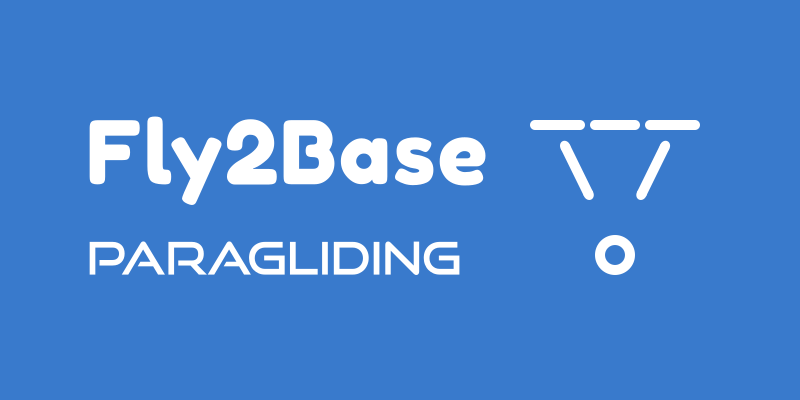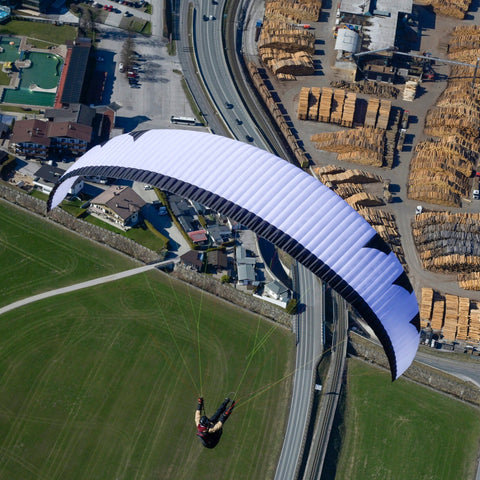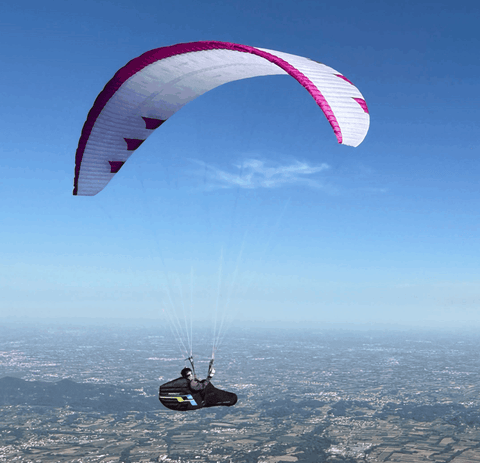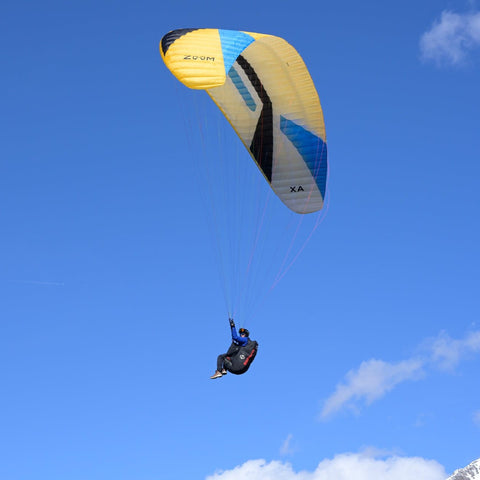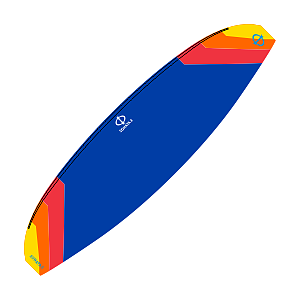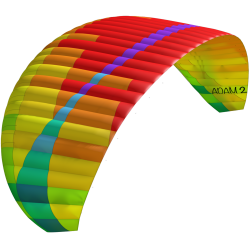NOVA Mentor 7 Light (EN B+)
2.5-Liner | 66 Cells | Aspect Ratio: 5.5 | Weight: from 3.65 kg | EN B
NOVA MENTOR 7 Light – Hybrid 2.5-liner
The NOVA MENTOR 7 Light is characterised by its completely new design as a "hybrid 2.5-liner" and carries the genes of the XENON. Thanks to the drastically increased performance, its cross-country potential sets new standards in the EN B class. With its intelligent, lightweight design, we are meeting the great demand for light, durable XC gliders.
ZILLERTAL BATTLE
Every spring, an EN B comp in Austria is called Zillertal Battle. Most manufacturers send their top pilots to fly their EN B gliders there. Mentor 7 won this comp twice in a row. This year (2024), they got 1st and 2nd place.
RESULTS OVERALL https://civlcomps.org/event/ZB2024/results/6612c3841080c
The best possible combination. This performance-optimised 2.5-liner flies more comfortably than many 3-liners. How come? Philipp Medicus, Head of R&D at NOVA explains: “The difference in design between the MENTOR 6 and 7 is greater than between the 2 and the 6. Everything is new. Only the pilot group and its potential as an XC machine are the same.” This means the MENTOR 7 Light will appeal to all cross-country pilots who want to achieve their distances within the B class and want a state-of-the-art “teacher”.
Technical Data
| Size | XXS | XS | S | M | L |
|---|---|---|---|---|---|
| Number of cells | 66 | ||||
| Projected span (m) | 8.65 | 9.10 | 9.54 | 9.96 | 10.37 |
| Projected area (m²) | 17.90 | 19.80 | 21.77 | 23.72 | 25.70 |
| Projected aspect ratio | 4.18 | ||||
| Flat span (m) | 10.78 | 11.34 | 11.89 | 12.41 | 12.92 |
| Flat area (m²) | 21.12 | 23.36 | 25.69 | 27.99 | 30.33 |
| Flat aspect ratio | 5.50 | ||||
| Line diameter (mm) | 0.4 / 0.5 / 0.7 / 0.8 / 0.9 / 0.95 / 1.2 | ||||
| Line length (m) | 6.47 | 6.81 | 7.14 | 7.45 | 7.76 |
| Max. chord (m) | 2.47 | 2.60 | 2.72 | 2.84 | 2.96 |
| Weight (kg) | 3.65 | 3.90 | 4.15 | 4.40 | 4.65 |
| Certified take off weight (kg) | 68-85 | 70-95 | 80-105 | 90-115 | 100-130 |
| Recommended take off weight (kg) | 70-80 | 80-90 | 90-100 | 100-110 | 110-125 |
| Certification (EN/LTF) | B | ||||
REVIEWS
The Mentor 7 Light earned our trust over many flights in difficult conditions. Being so easy to fly saves the pilot a lot of energy, making long XC flights less exhausting and thus safer. The technology sounds impressive, and you might be intimidated during the first demo flight. But it is a benign high-B glider, especially for its performance on full bar. A big plus is the handling: it has all the advantages of easier handling of a lighter wing but none of the disadvantages, such as a delicate build or jumpy behaviour. Nova has announced a full-fat version will arrive later. The only difference will be the heavier, abrasion-resistant fabric for use on less forgiving launches than grassy hills. Other than that, we don't know what one could want differently in a full-fat Mentor 7. Link to full NOVA Mentor 7 Light review. Cross Country Magazine
NOVA Mentor 7 Light review by Dust of the Universe Ziad Bassil
NOVA Mentor 7 Light review by Down Under Paraglider Reviews - Aaron Lugg
I am a convinced EN B-pilot with 36 years of paragliding and a clear focus on XC-flying. And as you know, I am the PR guy for NOVA and also take care of the NOVA Pilots Team. So, my following post can be called biased - but I would say the same to my best friends after five beers. I have flown all MENTORs as my "main wing". On the M4, 5 and 6, I was flying them at the upper end of the weight range (or even slightly above it), in my case, size S. Reasons: faster, crispier, climbing well enough on good days.
Luckily, I could try sizes S and M before wing delivery, so I changed to size M.
– It is still very, very fast,
– it is still incredibly stable and confidence-inspiring,
– I don't feel disadvantages in brake authority,
– I would even say I sense slightly more on the larger size (which was not the case with the previous models)
– it climbs better in weak conditions, of course.
In other words: it is a very nice wing for my kind of flying.
I am not the only NOVA Team Pilot who came to this conclusion. So, the MENTOR 7 (light) is not only a complete concept, but it may also require a change from the paradigm that you "must" fly wings on the upper end of the weight range. That is also why we at NOVA call the extra 5kg at the upper end of the TOW “extended” and NOT “recommended”. If you fly with many clothes in the winter or go on a vol-biv, you are still within the legal range. So, I advise all interested in the MENTOR 7 (light) to get a test flight on both neighbouring sizes for your weight.
Happy landings Till Gottbrath
I flew Mentor 7 Light S (80-100 kg 105 kg extended) at 103.5 kg for 2 hours. Aaron Lugg flew Mentor 7 Light XS 70-90 kg 95 kg extended at 90 kg. We both flew for 2 hours. We started with the slow climb in a gaggle with many wings. Aaron outclimbed everybody. I had a better climb than some other gliders from an EN D class, keeping up with EN C gliders. The Mentor 7 tracks in thermal very well. B3 big ear is awesome, I want that big ear on all my gliders now, easy to get it in, stable while in and clean pressurised reopening. The glider is very pitch stable for high B and well-behaved on the bar in turbulent air. Pleasantly responsive with a great amount of authority with B/C steering, the best B/C steering I've experienced on any 2,5/3 liner. When we landed and exchanged notes with Aaron, our first highlight was how well these gliders climbed. The second one was how easy they are to fly. The extra 5 kg on top of the XXS, XS, S and M sizes shall be seen as an extended weight range, and when selecting the glider size, pilots should consider the standard weight range identical to all other NOVA gliders. Making the top of the ideal weight range for size XS 90kg, size S 100 kg and so on.
The NOVA Mentor 7 Light user manual says, "The MENTOR 7 Light climbs well even when flown at the higher end of the weight range. Therefore, after intensive flight tests, we have extended our usual weight ranges for sizes XXS, XS, S and M upwards by 5 kg. On epic days, this can be used to fly at a high average speed." Martin Havel
Video
- NOVA Insights #8 – Philipp Medicus: 2.5-liners and new ways in development (in English)
- How SAFE is your HIGH B Paraglider? Theo de Blic testing the new NOVA MENTOR 7 Light.
- Theo de Blic explains the NOVA MENTOR 7 (Light)
Intelligent lightweight construction. Among other things, the MENTOR 7 Light owes its outstanding performance to the 66 cells and its complex inner construction. To live up to the name "Light", the wing features high-quality, durable lightweight materials. Ideal for ambitious cross-country flights and every conceivable hike & fly adventure
Optimised XC potential. The strength of the MENTOR 7 Light lies in its “actually usable performance”. Fully accelerated, it cuts solidly through unstable air masses, and the C-steering can be used to efficiently mitigate turbulence. Performance, smooth flying and safety are the hallmarks of a genuine MENTOR. The MENTOR 7 Light also impresses with its manageable extreme flight behaviour. For example, accelerated collapses are even more gentle than in the previous model. All NOVA test pilots confirm that this wing, with its moderate aspect ratio of 5.5, is very pleasant to fly and additionally has even more top speed than the MENTOR 6. The ideal prerequisites for breaking personal records.
Perfect pitch (control). The NOVA MENTOR 7 Light has Height Adjustable C-Handles (known as HAC handles) on the risers, that allow pitch control in accelerated flight, which was previously limited to two-liners such as the XENON. This means it is easy to compensate for turbulence and flying XC is far more efficient. Those with no previous experience in C-steering can take a relaxed approach to learning this new flight technology with the MENTOR 7 Light and gain a real performance advantage for themselves. Please note: how these C-steering works are explained below.
Elaborate design. Like our XENON, its "little brother", the NOVA MENTOR 7 Light does not work without rods. Therefore, we say goodbye to our "Easy Packing" principle in favour of a clear performance advantage. This just means that we recommend you don't stuff the MENTOR 7 Light into the packsack crumpled up but rather fold up and pack with the help of the enclosed pack roll. A little effort is worth it, as this means the rods remain in shape, the lines are tidier and it saves time during the preparation before the next flight. Please note: when buying the MENTOR 7 Light, you can decide between the Concertina Bag Light or a rucksack.
Multi-talented risers. The most prominent feature of the NOVA MENTOR 7 Light’s new Speedbrake Riser 2.0 is the HAC-Handles. Another striking feature is the "Baby-B" line, which acts as a moveable pulley on the B3 line. This means the riser is a little more complex, but it is still clearly laid out and easy to handle even when launching. Good to know when ground handling: you can kill the MENTOR 7 Light very effectively using the C-lines. As there is no C3 line, what does not work so well are asymmetric corrections via the C-lines. For lateral directional corrections, we, therefore, recommend using the brake.
Pilot target group
The MENTOR 7 Light (EN/LTF B) is a state-of-the-art "teacher" in the tradition of the MENTOR series (performance, smooth in flight, safety), which does not tend to overshoot during inflation and impresses with an extreme flight behaviour that is manageable for its class. As a hybrid 2.5-liner, it is suitable for cross-country pilots who are experienced in handling EN B gliders, or who want to get the maximum out of a flight using the speed bar and HAC handles. So if you want to familiarise yourself with pitch control similar to the flying feeling of a two-liner, this is the wing to fly. It is important to understand that the hybrid construction partly influences ground handling and means, for example, that the use of the B3 stall is more effective than classic big ears.
New Features
Hybrid design as a 2.5-liner. On the outer wing, the NOVA MENTOR 7 Light is a two-liner, and in the centre a three-liner. This means this “2.5-liner” does not have a C3 line. The smart redistribution of the attachment points and a profile optimised for accelerated flying make the MENTOR 7 Light a comfortable and potentially record-breaking fast cross-country glider. At the same time, the safety and smoothness in flight remain typical of the MENTOR and accordingly the certification also resulted in EN B certification.
Speedbrake Riser 2.0 incl. HAC Handles. The MENTOR 7 Light has HAC handles (Height Adjustable C-Handles) on the newly revised riser. With these, pitch movements in accelerated flight can be compensated for in the best possible way. This means that on cross-country flights you get from A to B even more efficiently - i.e. faster and with less sink. In addition, C-steering is very comfortable and requires little effort.
Aerodynamics optimised for speed. The design of the MENTOR 7 Light focused on speed. The profile ensures a high degree of pitch stability even at low angles of attack. In numerous simulations, the ballooning, as well as the stress distribution, was refined to minimise the deformation of the glider when accelerated. The cell openings are designed so that the internal pressure remains ideal even in accelerated flight. The result is excellent glide performance with an exceptional level of stability.


Scope of Delivery
- NOVA Concertina Bag Light
- Speed System Cords
- NOVA Pack Roll
- NOVA Windsock
- Repair Kit
- User Manual
NOVA 4 Years WARRANTY On Materials
We guarantee your paraglider for an additional three years*, covering materials and workmanship. If your wing undergoes NOVA Trim Tuning and a NOVA Full Service by an authorised NOVA partner, the guarantee extends to four years*. If repair isn’t possible, we will deduct the current value when purchasing a new NOVA paraglider.
NOVA 3 Years No Full Service Required
If your wing receives NOVA Trim Tuning, the standard two-year service check extends to three years (from the date of purchase), as long as you stay within the flight hours specified in the manual. This lets you focus on what you love—flying!
NOVA Trim Tuning
Over time, glider lines stretch or shrink, affecting performance. Typically, A and B lines stretch while C lines shrink, making the wing slower and less agile. NOVA Trim Tuning (NTT), developed with instructor and mathematician Ralf Antz, restores optimal performance. After 15-20 flight hours, send your wing to us or an authorised partner for measurement and trimming. Wings with NTT qualify for the 3-Year No Check Required guarantee.
NOVA Full Service
Our NOVA Full Service is more than a routine check—it ensures your glider is in top condition. We assess porosity, line lengths, and trim using our advanced Quality Assurance Database (QAD). All measurements are recorded, allowing technicians to make precise adjustments. This system helps us refine our designs for better safety and performance.
NOVA Quality Assurance Database
Your glider’s history is digitally stored in our QAD. Registering at MyNOVA grants access to all service records, including Full Service logs and Trim Tuning data. This system also helps us monitor material durability and improve future designs. NOVA service centres use QAD to assess your wing before servicing, enhancing knowledge transfer for better safety.
NOVA Registration & Query
Register your wing under the MyNOVA tab on the NOVA website to activate extended warranties and guarantees.
You can book the service here.
The lead time for the service is 3 months. Turnaround for the service work is 1-2 weeks. https://forms.gle/EskshqFdwcvPDB7q8
More details on the manufacturer's website under the Service tab: NOVA
You have to have the training and a licence to fly a paraglider. Check with your instructor if you are buying your first paraglider.
We Also Recommend
